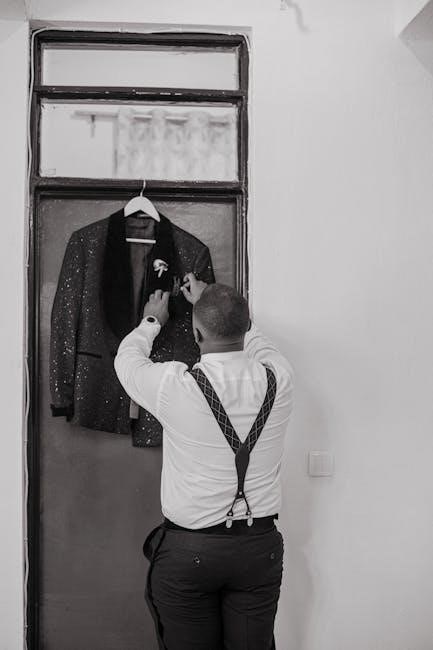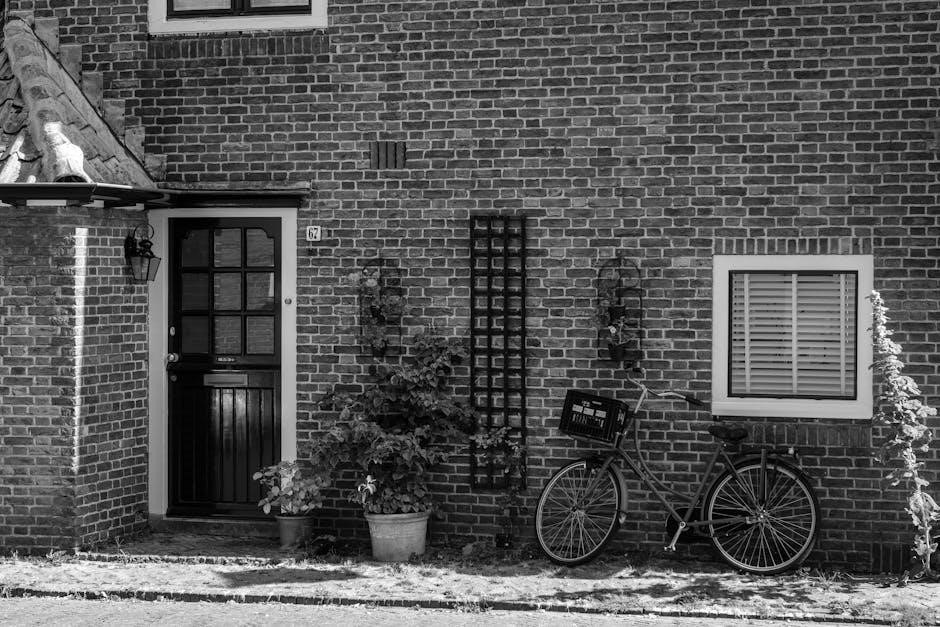Proper door closer adjustment ensures smooth operation, safety, and longevity. It regulates closing force, speed, and alignment, preventing damage and ensuring compliance with accessibility standards. Regular adjustments maintain optimal functionality and energy efficiency, crucial for both residential and commercial settings.
1.1 Importance of Proper Door Closer Adjustment
Proper door closer adjustment is essential for ensuring safety, functionality, and longevity. It prevents excessive wear and tear, reduces the risk of accidents, and maintains optimal performance. Incorrect adjustments can lead to doors closing too fast or failing to latch, causing damage or injuries. Proper adjustment ensures compliance with accessibility standards and energy efficiency requirements. It also minimizes maintenance needs and extends the lifespan of the door and closer. Correct settings ensure smooth operation, preventing premature wear on hinges and frames. Regular checks and adjustments are vital for maintaining a secure and efficient door system in both residential and commercial environments.
1.2 Basic Components of a Door Closer
A door closer consists of key components essential for its operation. The main body houses the hydraulic mechanism controlling closing force and speed. The arm rod connects the closer to the door, providing structural support. Adjustments are made via valves regulating closing and latching speeds. The backcheck slows the door near the closed position, preventing damage. Mounting brackets secure the closer to the door frame. These components work together to ensure smooth, controlled door movement. Proper understanding and maintenance of these parts are crucial for effective adjustment and optimal performance. Each element plays a vital role in the overall functionality of the closer system.

Tools and Materials Needed
Essential tools include Phillips and flathead screwdrivers, protective gloves, and a screwdriver set. These ensure safe and precise adjustments to the door closer mechanism. Proper tools are crucial for effective adjustments and preventing damage. Gloves protect hands during handling, while screwdrivers facilitate precise tweaks. Having the right tools ensures efficiency and accuracy in the adjustment process.
2.1 Screwdrivers (Phillips and Flathead)
Screwdrivers are essential for adjusting door closers. Phillips screwdrivers are used for screws with a star-shaped head, while flathead screwdrivers handle slotted screws. Both types are necessary for accessing and adjusting internal components like valves and brackets. When loosening or tightening screws, apply gentle, consistent pressure to avoid stripping the heads. Ensure screwdrivers are of high quality to maintain grip and control during adjustments. Proper use of screwdrivers prevents damage to the closer and ensures precise adjustments, making them indispensable tools for the task.
2.2 Protective Gloves
Protective gloves are crucial for safeguarding hands during door closer adjustments. They prevent cuts, abrasions, and injuries from sharp edges or tools. Durable materials, such as heavy-duty rubber or synthetic fabrics, provide excellent grip and protection. Wearing gloves ensures a secure hold on tools, reducing the risk of accidents. Additionally, gloves protect against potential oil or grease exposure from the door closer’s hydraulic components. Proper hand protection is essential for safe and effective adjustments, allowing for better control and precision when handling small parts or tools. Always prioritize hand safety to avoid interruptions and ensure a successful adjustment process.
2.3 Screwdriver Set
A screwdriver set is an essential tool for door closer adjustments, offering versatility for various tasks. It typically includes Phillips and flathead screwdrivers, necessary for accessing and adjusting internal components. The set should feature durable handles for a secure grip and tips that fit snugly into screws to prevent stripping. Adjustable screwdrivers with interchangeable bits can also be useful for different screw types. A comprehensive set ensures you’re prepared for any adjustment, from loosening valves to tightening brackets. Having the right screwdrivers on hand streamlines the process, saving time and effort during adjustments. Always choose high-quality tools for reliability and precision.

Pre-Adjustment Checks
Before adjusting, inspect the door and frame alignment to ensure proper fit. Check for wear and tear on hinges, brackets, and arms to identify potential issues early, ensuring effective adjustments and preventing further damage.

3.1 Inspecting the Door and Frame Alignment
Before making any adjustments, inspect the door and frame alignment to ensure proper fit. Look for gaps or misalignment that could affect the closer’s performance. Check if the door hangs evenly and aligns with the frame when closed. Misalignment can cause uneven stress on the closer, leading to premature wear. Use a level tool to verify the door’s plumb and the frame’s squareness. Addressing alignment issues first ensures that subsequent adjustments are effective and prevents unnecessary strain on the door closer mechanism. Proper alignment is crucial for smooth operation and longevity of the door closer system.
3.2 Checking for Wear and Tear
Inspect the door closer for signs of wear and tear, such as rust, damaged parts, or excessive play in the arm rod and main arm. Ensure all components are securely attached and functioning properly. Lubricate moving parts to maintain smooth operation and prevent corrosion. Addressing wear early can prevent costly repairs and ensure the door closer operates efficiently. Regular maintenance is key to extending the lifespan of the door closer and maintaining door functionality and safety.

Step-by-Step Adjustment Instructions
Begin by removing the cover and closing all valves. Adjust the backcheck, sweep/main speed, and latching speed as needed. Follow each step carefully for optimal results.

4.1 Removing the Cover
To access the internal components of the door closer, start by removing the cover. Use a Phillips screwdriver to unscrew the retaining screws. Gently pull the cover away from the closer body. Be cautious not to force it, as this may damage the finish or surrounding material. Once removed, set the cover aside in a safe place to avoid losing it. Ensure the area around the closer is clean to prevent dirt or debris from entering the internal mechanisms. Avoid touching electrical or hydraulic components to prevent contamination. Proceed to the next step only when the cover is fully removed and the area is clear.
4;2 Closing All Valves
After removing the cover, locate the adjustment valves. Use a screwdriver to turn the main speed valve and the backcheck valve clockwise until they stop. This action slows the door’s closing speed and prepares it for precise adjustments. Ensure all valves are fully closed to prevent any unintended movement during the adjustment process. Closing the valves properly stabilizes the door closer’s hydraulic system, allowing for accurate fine-tuning of the closing and latching speeds. Always handle the components with care to avoid damage. Once all valves are closed, proceed to the next adjustment step. This ensures the door closer operates smoothly and safely.

4.3 Adjusting the Backcheck
Locate the backcheck adjustment valve, typically found near the main arm. Use a screwdriver to turn the valve counterclockwise to increase resistance or clockwise to decrease it. This adjustment controls how far the door opens, preventing it from swinging too wide. Turn the valve slightly, then test the door’s movement. Repeat until the door opens to the desired range without excessive force. Be cautious not to over-tighten, as this could damage the mechanism or restrict proper door operation. Proper backcheck adjustment ensures safety and prevents potential damage to the door and frame. Adjust in small increments for precise control.
4.4 Adjusting the Sweep/Main Speed
Locate the main speed adjustment valve, typically positioned near the closer’s body. Use a screwdriver to turn the valve clockwise to slow down the sweep speed or counterclockwise to increase it. This adjustment controls how quickly the door moves from the full-open position to the closed position. Make small increments, testing the door’s movement after each adjustment. Ensure the door closes smoothly without slamming or moving too slowly. Proper adjustment ensures balanced operation, reducing wear and tear. If the door closes too fast, turn the valve clockwise; if too slow, turn it counterclockwise. Align the arm at a 90-degree angle for optimal performance. Adjusting the sweep speed ensures the door closes efficiently and safely, maintaining consistent operation over time. Regular fine-tuning may be needed based on usage and environmental factors.
4.5 Adjusting the Latching Speed
Locate the latching speed adjustment valve, usually found near the closer’s body; Use a screwdriver to turn the valve clockwise to slow the latching speed or counterclockwise to increase it. This adjustment fine-tunes the door’s final closing motion, ensuring it latches securely without slamming. Make small, incremental turns and test the door’s movement after each adjustment. Proper latching speed ensures the door closes firmly but gently, preventing damage to the frame or hardware. If the door does not latch properly, adjust the valve slightly clockwise. Align the arm at a 90-degree angle for optimal performance. Regular adjustments maintain smooth operation and extend the door closer’s lifespan.

Fine-Tuning the Door Closer
Fine-tuning involves adjusting the closing force, delay time, and aligning the arm rod and main arm. These adjustments ensure optimal performance, safety, and longevity of the door closer system.
5.1 Adjusting the Closing Force
Adjusting the closing force ensures the door shuts securely without excessive power. Locate the adjustment screw on the closer. Turn it clockwise to decrease force or counterclockwise to increase it. Make small increments, testing the door’s movement after each adjustment. Proper force prevents damage and ensures smooth operation. Refer to the EN value on the display for compliance. Over-tightening can cause resistance, while too little force may leave the door ajar. Fine-tune carefully for balance and safety, ensuring the door closes efficiently and meets all regulatory standards.
5.2 Setting the Delay Time
Setting the delay time involves adjusting how long the door remains open before closing automatically. Locate the delay adjustment valve on the closer. Turn it clockwise to decrease the delay time or counterclockwise to increase it. Adjustments are typically made in small increments, such as 1/8 of a turn, to achieve the desired timing. Test the door’s response after each adjustment to ensure smooth operation. The delay time can range from a few seconds to approximately 50 seconds, depending on the closer model. Proper delay settings enhance user convenience and ensure the door functions efficiently in various environments.
5.3 Aligning the Arm Rod and Main Arm
Aligning the arm rod and main arm ensures proper door closure and prevents wear. Begin by loosening the connecting screw. Slowly rotate the arm counterclockwise until it touches the door’s top edge. Then, turn it clockwise to reach the desired position. Tighten the screw once aligned. Ensure the arm rod forms a 90-degree angle with the closer body for optimal functionality. Misalignment can cause uneven closing or damage, making precise adjustment crucial. Regular checks maintain alignment, especially after adjustments or repairs, ensuring smooth and reliable door operation over time.

Maintenance and Upkeep
Regular lubrication of moving parts and inspecting for wear are essential. Replace worn components promptly to ensure proper function and prevent premature failure over time.
6.1 Regular Lubrication

Lubricating the door closer’s moving parts is crucial for smooth operation. Apply silicone-based spray or grease to hinges, pivot points, and arm joints. This reduces friction, prevents corrosion, and ensures consistent performance. Lubrication should be done every six months or when signs of wear appear. Avoid using heavy oils, as they may attract dust and compromise functionality. Regular maintenance helps extend the lifespan of the door closer and maintains optimal closing and opening speeds. Always refer to the manufacturer’s guidelines for specific lubrication recommendations to ensure compatibility and effectiveness.
6.2 Replacing Worn-Out Parts
Replacing worn-out parts is essential for maintaining door closer performance. Common parts to replace include the arm rod, main arm, and backcheck. Use a screwdriver to remove screws securing these components. Protective gloves ensure safe handling. Inspect parts for wear and tear during replacement. If adjustments no longer improve functionality, it’s time to replace them. Source replacement parts from the manufacturer or hardware stores. After installation, test the door’s operation to ensure proper alignment and smooth movement. Regular replacement prevents further damage and ensures the door closer operates efficiently and safely over time.
Troubleshooting Common Issues
Identify issues like uneven closing speeds or improper latching. Check valve adjustments and backcheck functionality. Ensure all parts are secure and properly aligned for optimal performance.
7.1 Door Closing Too Fast or Too Slow
If a door closes too fast, adjust the closing speed valve counterclockwise to slow it down. Conversely, turn the valve clockwise for faster closure. Ensure minor adjustments, about 1/8 of a turn, and test repeatedly. Avoid over-tightening to prevent damage. Regular lubrication and part inspection can help maintain balanced operation. Always refer to the manufacturer’s guidelines for specific instructions on speed regulation and maintenance.
7.2 Door Not Latching Properly
If the door fails to latch properly, check the alignment of the arm rod and main arm. Fix the arm rod at a 90-degree angle to the closer body and tighten the screw. Adjust the backcheck and latching speed to ensure smooth operation. If issues persist, inspect for worn-out parts and replace them. Proper alignment and adjustment of these components are crucial for ensuring the door closes and latches securely. Regular maintenance and lubrication can also prevent such problems. Always follow manufacturer guidelines for specific adjustment instructions.
7.3 Backcheck Not Functioning Correctly
If the backcheck is not functioning properly, it may cause the door to swing too forcefully or not slow down during opening. To fix this, adjust the backcheck by turning the adjustment screw clockwise to increase resistance or counterclockwise to decrease it. Make minor adjustments, testing the door’s movement after each turn. If the issue persists, ensure the arm rod and main arm are properly aligned. Incorrect alignment can disrupt the backcheck’s functionality. Regular lubrication and inspection of moving parts can also help maintain proper operation. Always refer to the manufacturer’s instructions for specific adjustment guidelines.
Safety Considerations
Ensure proper closing force to prevent injury. Avoid over-tightening, as it may cause the door to close too forcefully. Always follow manufacturer guidelines.
8.1 Ensuring Proper Closing Force
Proper closing force ensures the door closes securely without causing injury. Adjust the closing force screw to meet EN standards, visible on the display. Turning clockwise decreases force, while counterclockwise increases it. Make minor adjustments, testing after each turn. Avoid over-tightening, as it may lead to excessive force. Always refer to manufacturer guidelines for specific EN value ranges. Proper force ensures accessibility and safety, preventing accidents and maintaining compliance with regulations. Regular checks and adjustments are essential to uphold these standards and ensure smooth, safe operation of the door closer system.
8.2 Avoiding Over-Tightening
Avoiding over-tightening is crucial to prevent damage to the door closer and ensure proper functionality. Use a screwdriver to adjust screws gently, making small turns and testing after each adjustment. Over-tightening can lead to excessive closing force or improper alignment, potentially causing wear and tear on components. Always refer to manufacturer guidelines for recommended torque levels. If over-tightened, loosen slightly and test operation. Proper adjustment ensures safety, efficiency, and longevity of the door closer system, avoiding costly repairs and maintaining smooth, consistent performance over time.
Proper door closer adjustment is essential for maintaining functionality, safety, and longevity. By following the outlined steps and safety guidelines, users can ensure smooth operation and prevent potential damage. Regular maintenance and timely adjustments are key to optimal performance. Always refer to manufacturer instructions and use appropriate tools to avoid over-tightening or misalignment. Properly adjusted door closers contribute to energy efficiency, accessibility, and overall user satisfaction. Remember, minor adjustments can make a significant difference, so take the time to fine-tune settings for the best results. This guide provides a comprehensive approach to achieving and maintaining a well-functioning door closer system.

No Responses